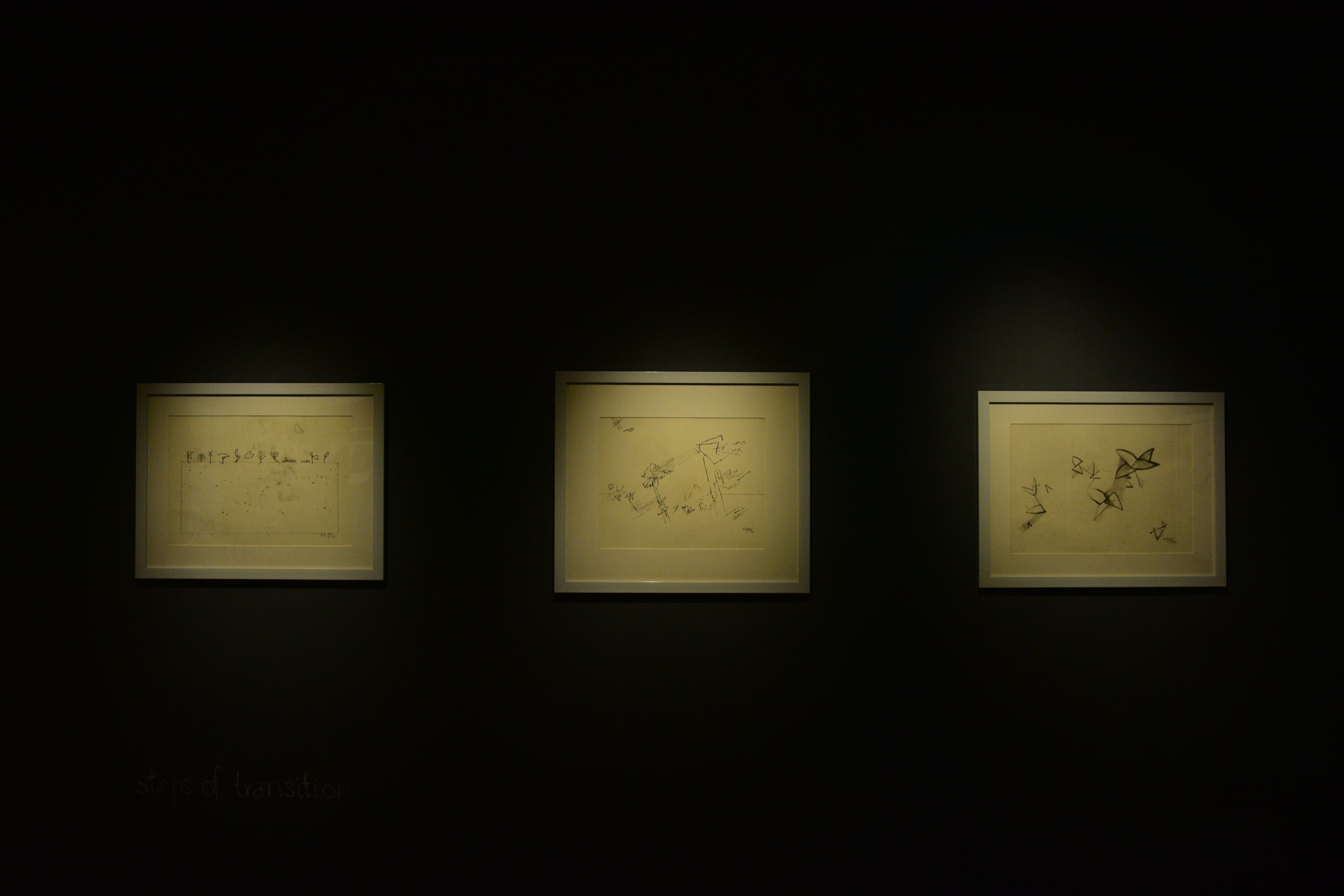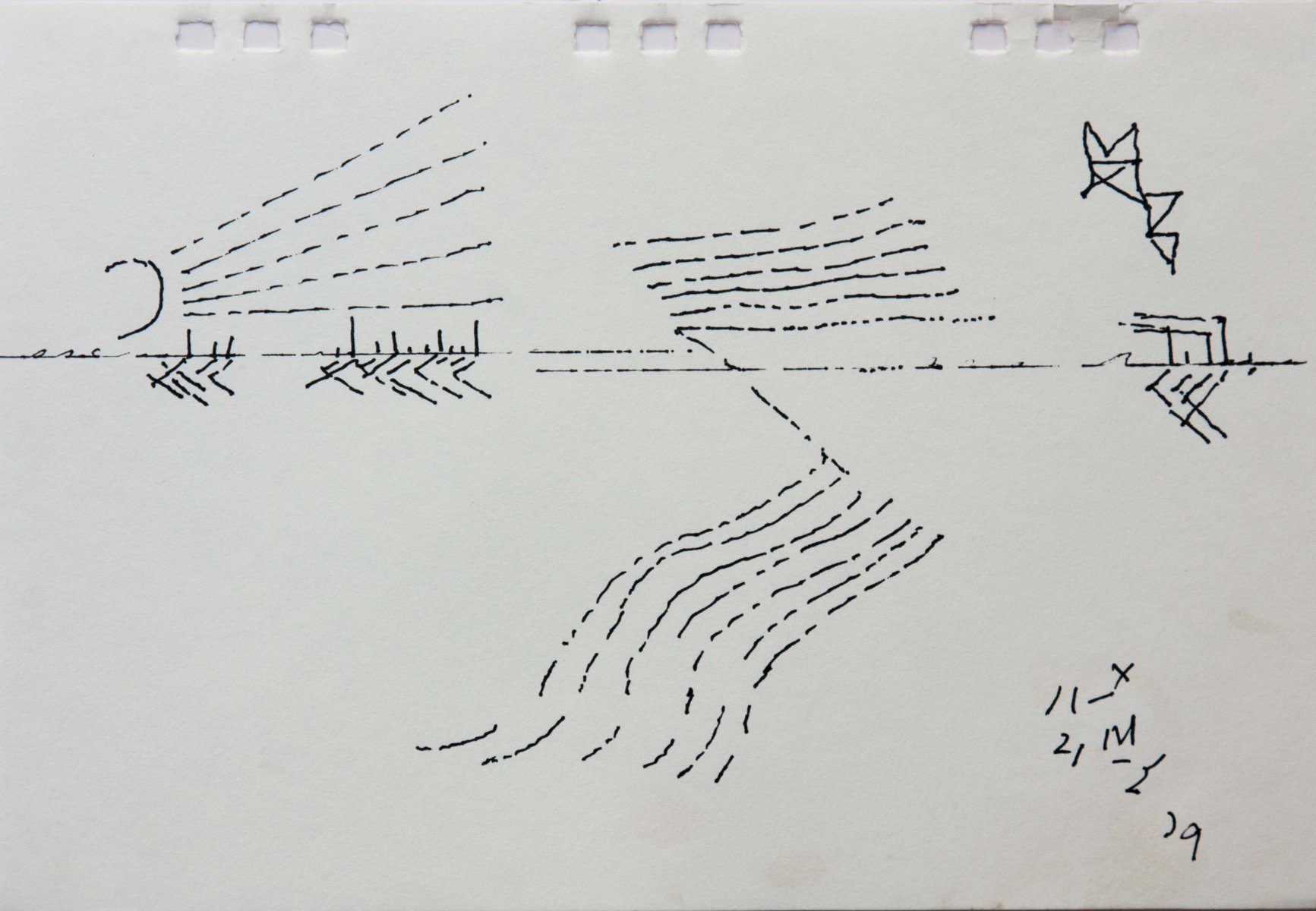
Poetics of Abstraction by Ganesh Haloi
January 15 – February 24, 2018 at Akar Prakar, Kolkata
Ganesh Haloi, an explorer of the abstract idioms within life and the world of nature, has been consistently exploring the sensations between form, colour, space and volume. Creating an invisible rhythm between them, the abstract compositions are rooted in the formal discipline of minimalism and the intuitive distillations of nature. Both the poetry of Jibananandas Das and the philosophical enquiries of Nature and the Self have been imbibed into his visual perception innately balancing the gaze between the outer-inner, seen-unseen and reality-perception.
Into the half light and shadow go I. Within my head
Not a dream, but some sensation works its will.
Not a dream, not peace, not love,
A sensation born in my very being.
I cannot escape it
For it puts its hand in mine,
And all else pales to insignificance--futile, so it seems,
- Jibanananda Das
A process that allows him to charter his own visual poetics oscillating between gestural abstractions, symbolic representations, special orchestrations and colour constructions. However, this exhibition is focusing on his monochromatic discipline where the colour black is explored as a volume against the natural white textured surface of the paper. Tensions between the two polar colours and the dance between their relationship using different tonalities and compositions are witnessed through the works from 1998 to 2017.
Nature and its hidden dynamics has been the constant muse for Haloi. His early works from the period of 1998-99 have been distinctly symbolic and are animated expressions of nature delineated in thick linear forms encompassing space and movement bearing subtle impressions of Kandinsky’s linear compositions. More peculiar is the work ‘Yoga and Meditation’ painted in the year 1998, which directly connotes the Benares Ghats with its linear compositional perspective reminiscing that of an Indian miniature painting. Conceptually the three levels or ghats might also resonate with the levels of consciousness that one attains with the practice. Furthermore, if you allow a streak of imagination to break away from the obvious narration and observe, each level then represents itself as a mirror image of the other. Not exact but as angular reflections, off one to the other, an attempt to create an infinity of images that transcends time and dimension. It’s interesting to note that the only images that are not reflected are the man at the bottom and the bicycle along with the words at the centre, philosophically drawing the relation between man and the cosmos. The man represents the static element of life and can experience the cosmos in its ever-changing infinite dimensions through yoga and meditation. Not by renouncing life but by balancing both. Thus the cycle and the title take centre stage in the composition.
Always another path you seek: today I seek no more.
I found in that void on the far shore something to hold at last
In my own heart, own mind. . . .
— Jibanananda Das
This work is constructed with angular brick like forms unlike the free flowing formation of the other two untitled works of this period (figure 1 & 2). The artist allows the forms to take shape from the flat brush strokes, laying emphasis only on movement and pressure, naturally allowing the gradations to formulate. This process is consistent in the later works too (2010-14). However, the works of this latter period are more gestural, breaking away from the physicality of nature and trying to capture its vital movements, peculiar of the primitive and folk art expressions (see figures 4, 5 & 6). Forms are broken free from their rigid physical boundaries and the artist is demarcating their inner vital constructions, transforming them further into mathematical abstractions derived from psychological and intuitive impressions.
Haloi’s miniature works of 2017 resonate mathematical formulations attempted by scientists/physicists in order to understand the inner workings of nature and its elements. The thick brush strokes are thinned down in order to capture the subtlest vibratory elements and formulas existing within space that is unseen and yet experienced by artist. The universe, including all its elements, is in constant motion, ever changing and evolving — a statement made by philosophers and physicists — is the constant subject of enquiry. Other artists too have tried to express this dubiety, for example Van Gogh’s ‘Starry Night’, or more precisely his unique style using swirls is an expression of this vibratory motion as experienced by him in the physically static forms and elements of nature. However, his expressions were limited to the landscapes, not abstracting the linearity of it. On the other hand through these miniature drawings Haloi abstracts all sense of perspective and is attempting to orchestrate a rhythmic pattern between all elements of the landscape (seen and unseen). Abstracting its very essence of foreground/background/underground and redefining their metrical relations through the simplicity of lines bridging dimensions. His compositions that comprise of squiggles, swirls, dots and a variety of lines (dotted, straight and curved) reflect upon similar vibratory motions that resonates the unheard hum of the universe, mapping the hidden connections and the subtle links that join all creations.
O blue skies unblinking,
O magician,
you have with your magic wand
Cracked the very foundation of this prison of a thousand rules and laws.
— Jibanananda Das
Gestural brush strokes are transformed into meditative formulas of rhythm. Haloi has through this process defined a poetics, which is singular and yet universal, bearing characteristics of an ever-progressing artist defining the term abstraction in many dimensions. The exhibition also includes a few recent coloured aquarelles, which resonate with his mathematical formulations of form, space and movement like symbolic signals seen on a cave wall. They hold a volume of earth unlike the miniature compositions, which are more ethereal, bridging space and time. Ganesh Haloi transitions through these mediums seamlessly, glimpsing the many facets of nature from its material physical form to its metaphysical timeless cadences, thus giving the viewer a complete experience. Some compositions build upon these poetics while some leave us perplexed. Whatever the experience, it draws us into a consciousness that triggers a rhythm that we all unconsciously yearn for. A mystery left for the viewer to unveil. The dimensions fold and embed the clusters of emotions, which engulf us with an aura of creation, teasing our minds and emotions to synchronise with the poetics of his abstractions.
Jesal Thacker
Ganesh Haloi | Untitled | Gouache on board | 19.75 x 29.5 in | 2016
Ganesh Haloi | Untitled | Watercolour on paper | 21.5 x 25.5 in | 1996
Ganesh Haloi | Untitled | Watercolour on paper | 10.5 x 13.75 in | 2011
Ganesh Haloi | Untitled | 28.25 x 22.25 in | 1998
Ganesh Haloi | Untitled | Watercolour on paper | 10.5 x 13.75 in | 2012
Ganesh Haloi | Untitled | Watercolour on paper | 10.5 x 13.75 in | 2011
Ganesh Haloi | Untitled | Watercolour on paper | 22 x 22 in | 1998
Ganesh Haloi | Untitled | 8.5 x 11.75 in | 2017
Ganesh Haloi | Untitled | 8.5 x 11.75 in | 2017
Ganesh Haloi | Untitled | 5.5 x 8.75 in | 2017
Ganesh Haloi | Untitled | 5.25 x 7.5 in | 2017
Ganesh Haloi | Untitled | 5.25 x 7.5 in | 2017
Ganesh Haloi | Untitled | 5.25 x 7.5 in | 2017
Ganesh Haloi | Untitled | 5.25 x 7.5 in | 2017
Ganesh Haloi | Untitled | 5.25 x 7.5 in | 2017
Ganesh Haloi | Untitled | 5.25 x 7.5 in | 2017
Ganesh Haloi | Untitled | 11.25 x 14.5 in | 2017
Ganesh Haloi
‘I can sense, feel and even see everything out there and in my works. Not only the tangible physical world and its nurturing forces, but I can also see the elusive atmospheric elements – the ethereal ones like the wind, air, light, darkness, sound, resonance, silence, movement, vibration, rhythm, everything. You can find all these elements in my works.’
Ganesh Haloi was born in Jamalpur, Mymensingh- presently a part of Bangladesh- in 1936. He moved to Calcutta in 1950 following the partition.
The trauma of displacement left its mark on his work as it did on some other painters of his generation. Since then his art has exhibited an innate lyricism coupled with a sense of nostalgia for a lost world. In 1956, he graduated from the Government College of Art and Craft, Calcutta.
In the next year he was appointed by the Archaeological Survey of India to make copies of Ajanta murals. Seven years later, Haloi returned to Calcutta. From 1963 until his retirement, he taught at the Government College of Art and Craft. He is a Member of The Society of Contemporary Artists, Calcutta since 1971, and lives and works in Calcutta. He has participated in several group exhibitions in India, Greece/Germany (Documenta 14 at Athens & Kassel), California (Architecture of Life, at Berkeley Art Museum & Pacific Film Archives (BAM/PFA), Berkeley), Berlin (8th Berlin Biennale for Contemporary Art), London (A Special Arrow Was Shot in the Neck, David Roberts Art Foundation) and New York (Past Parallels: The Art of Modern & Pre-Modern India at Aicon Gallery). He is represented by Akar Prakar Kolkata and New Delhi, and has had various solo exhibitions in Kolkata, Delhi, Mumbai and Dhaka. He has recently been awarded the Lifetime Achievement Award (2019) by India Today. In October 2020, a retrospective of Haloi will be hosted by Chhatrapati Shivaji Maharaj Vastu Sangrahalaya (CSMVS), Mumbai, in collaboration with Kiran Nadar Museum of Art (KNMA), with the support of Akar Prakar. The retrospective will be curated by Roobina Karode, Director and Chief Curator, KNMA. His artworks were exhibited in Asia Week New York (AWNY) in March 2020.



















